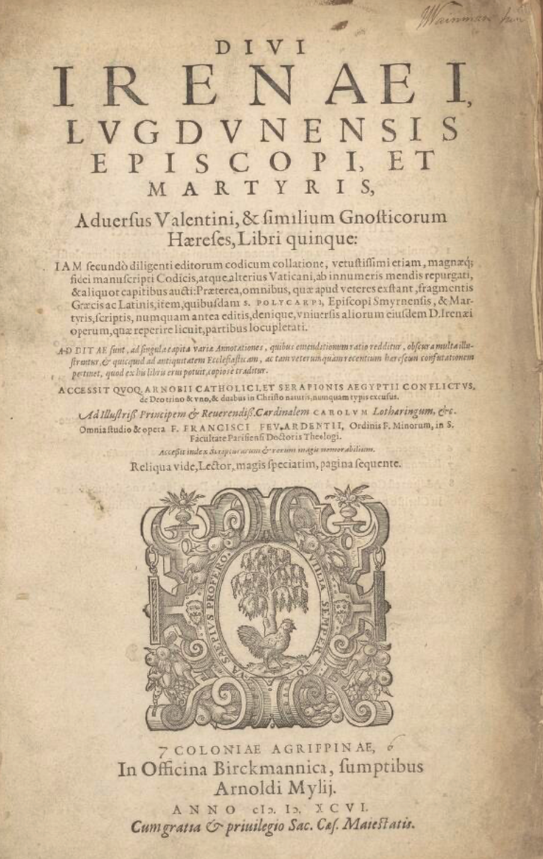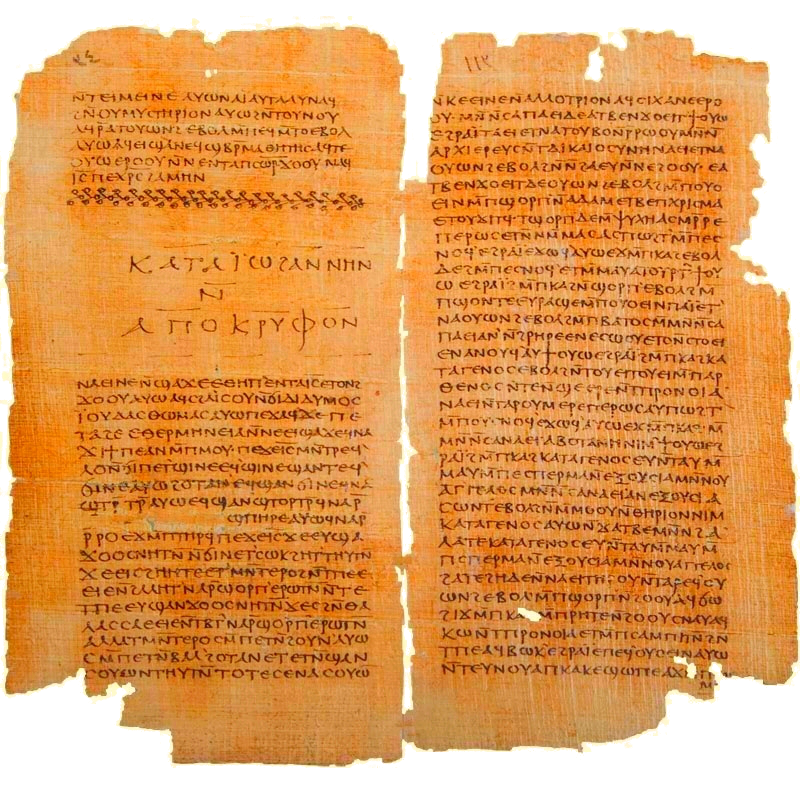Introduction
 Gnosticism
does not exist. This is a claim made by many scholars of Gnosticism.1 The term ‘Gnosticism’ is derived
from the Greek term gnōsis, similar in some ways to the English
concept of ‘acquaintance’. Gnōsis refers to ‘acquaintance’ with
God, the self, and the savior — or one or two of those depending on the
specific Gnostic sect. But this God is not the God of the Hebrews, nor
the God of the Christians, but the ‘true’ God above them. Gnosticism is
a label first and foremost devised by Church Fathers from Antiquity,
such as Irenaeus of Lyons and Epiphanius of Salamis, who denounced these
deviant sects as heresies in texts often cllaed Adversus
Hereses.
Gnosticism
does not exist. This is a claim made by many scholars of Gnosticism.1 The term ‘Gnosticism’ is derived
from the Greek term gnōsis, similar in some ways to the English
concept of ‘acquaintance’. Gnōsis refers to ‘acquaintance’ with
God, the self, and the savior — or one or two of those depending on the
specific Gnostic sect. But this God is not the God of the Hebrews, nor
the God of the Christians, but the ‘true’ God above them. Gnosticism is
a label first and foremost devised by Church Fathers from Antiquity,
such as Irenaeus of Lyons and Epiphanius of Salamis, who denounced these
deviant sects as heresies in texts often cllaed Adversus
Hereses.
The Acts of Gnosticism
The most well-known Gnostic sects, like that of Valentinus (c. 100-180 AD) and Basilides (c. end of first and beginning of second century AD) survived for approximately three centuries. From the very beginning of the circulation of Gnostic ideas, diversity and multiplicity were abundant, but there were a few ‘roots’ shared by most sects. Most apparent of these is the fact that the sects share a complex and distinctive myth of origin, and with that also came a special jargon or in-group language.2
Bentley Layton identifies that the shared mythology tends to follow a structure of four ‘Acts’ that overlap a sub-plot. The first Act covers the expansion of a solitary First Principle (God) into a non-physical universe, this Layton calls the expansion of divine power. Act II covers the creation of the material universe, during which a theft of some of the divine power occurs by an evil (or simply ignorant) offspring of Intellect, called Ialdabaoth (or Yaldabaoth, Ialtabaoth, Yaltabaoth). During Act III Adam, Eve, and their children are created. Their physical being is created by Ialdabaoth and his Rulers, referred to as Archons. In non-Gnostic Christianity these are considered angels and demons. But the spiritual being of the humans embodies deception of Ialdabaoth, as he loses the remainder of his own spiritual being and so humans become more powerful than him. Finally, in Act IV, the subsequent history of the human race occurs. During this history, the return of the spiritual humans to the First Principle is the main goal of the ‘Gnostics’.3 This final Act is the Act the Gnostics believe we are currently in.
It is evident that the Gnostic myth undermines the foundations of ‘mainstream’ Christian thought. The very God they worship is deemed evil or ignorant, his angels are wicked henchmen, and the world created by the benevolent Lord for mankind to use is in fact a prison. On top of that, those who reject this are sometimes thought not even to be human. Valentinus, for example, makes a distinction between physical, spiritual, and psychical people in his The Tripartite Tractate (TrTr). Spiritual people would attain salvation, psychical people only in part, and the material people were doomed.4
Gnosticism in Late Antiquity
The Gnosticism of such sects as the Valentinians and Basilideans did
not enjoy a particularly long lifespan. The dating of the oldest Gnostic
texts is a point of contention between scholars, but most scriptures
taken as truly ‘Gnostic’ texts seem to go back to the late first or
early second century AD, such as The Gospel of Thomas (GTh) and
The Gospel of Truth (GTr).5 The Gnostic sects mostly
went extinct after the fifth century AD, with the exception of
semi-Gnostic sects such as the Mandaeans, who until this day remain
active — though as a diaspora, and in recent  years have
been pushed to near-extinction.6
years have
been pushed to near-extinction.6
The literary persecution of Gnostics took on the most extreme forms imaginable. Perhaps the best example of this is Epiphanius of Salamis’ writings on the Borborites (also called Phibionites), a Gnostic sect in Egypt. His Panarion (specifically chapters 25 and 26) described the Borborites as being a licentious sect that embraces intercourse for pleasure, polyamory, and gluttony to the point of fetus-eating: 7
“They extract the fetus at the stage which is appropriate for their enterprise, take this aborted infant, and cut it up in a trough with a pestle. And they mix honey, pepper, and certain other perfumes and spices with it to keep from getting sick, and then all the revellers in this herd of swine and dogs assemble, and each eats a piece of the child with his fingers.”8
Gnosticism Revived?
Despite the persecution of these ‘heretics’ in late antiquity into almost-oblivion, this very same persecution constituted the survival of much of ‘Gnostic’ thought accessible until the discovery of the Nag Hammadi Codices (NHC) in 1945 until which some of the only Gnostic sources not labelling it as heresy were those of Basilides. During the Middle Ages, writings on ‘Gnosticism’ and its profanations disappear (almost) completely. But with the renewed interest in ancient scripture, religion, and the early years of the church during the Renaissance, the writings of Irenaeus, Epiphanius, and Tertullian were rediscovered — and along with them also the Gnostics they criticized.
Such texts were translated and reinterpreted throughout the Renaissance. See, for example, Irenaeus’ Adversus Valentini, & similium gnosticorum haereses, libri quinque, printed in Cologne in 1596. The same text is printed again in 1639: Adversus Valentini, & similium Gnosticorum Haereses Libri quinque, by Smyrnaeus Polycarpus in Paris. And again in 1734: Irenaeus, Contra haereses libri quinque, in Venice.9
Imitating the argumentative scriptures of these ancient Church Fathers became a somewhat popular effort in the eighteenth century, as indicated by numerous dissertations written on Gnostic sects, their doctrines, their practices, and above all their wickedness. The Catalogue of the Embassy of the Free Mind contains several of such dissertations.
One example is a dissertation by Johann Justus Losius on the Aeons of Valentinus and the names of the angels. Losius shows remarkable understanding of ancient scriptures, citing from such influential texts as Plato’s Timmaeus — which was central to especially Valentinus’ doctrine of monism and the imperfection of materiality — and applying knowledge of not only (translated) Latin sources, but also of Hebrew and Greek sources.10 Another example is provided by Konrad Samuel Schurzfleisch and Johann-Christian Closius, who write about the meaning of ‘Caulacau’, which to Basilides was the mystic name of Jesus Christ. Through the knowledge of such mystic names, one could ascend to the spiritual realm.11
Content of the Dissertations
The content of such dissertations differed greatly, as some, like Schurzfleisch and Closius, analyzed and criticized the interpretation of such holy matters as the essence of Jesus Christ, while others, like Losius, try to limit their analysis to a summarizing of the contents of the texts by the Church Fathers and discern the specific worldviews held by Gnostics like Valentinus, making sure to ridicule some of those views between the lines.
Another peculiar example is provided by Petrus Almstedt’s Dissertatio Historico Philosophica, de Secta Gnosticorum, published 1775. This text, which is the latest published work mentioned here, references ‘the Gnostic sect’, which assumes or at least leads the reader to assume that there is or was a single Gnostic sect against which the Church Fathers argued, while in reality a multitude of sects were active throughout Southern Europe, the Middle East, and Northern Africa. Almstedt opens his dissertation by stating:
‘That in the first century after the birth of Christ a certain sect came into existence, that justified the name of the Gnostics and disturbed the Christian religion by various and pernicious errors, is a fact agreed upon by all those who have recorded the history of that time.’12
Conclusion
It is evident that objectivity played no part in the analysis of the Gnostics, both by the Church Fathers in Late Antiquity, and by those rediscovering their texts a millennium later. But is this really surprising? Most of what these writers had access to, and thus most of their materials to work with, were already heavily prejudiced. Besides, the pre-Nicaean nature of those Gnostic sects meant that they could not have knowledge of the doctrines deemed ‘correct’ by the Church, and they thus made an easy target to write a dissertation on. It is interesting, however, to see how professional, relative to modern academic standards, these dissertations are in other regards. With a multitude of references to both ancient and contemporary sources, the critiques on the Gnostics were justified in such a way that made it seem a foolish, and obviously blasphemous, quest to counter this ‘academic’ trend.
Almstedt, Petrus. Dissertatio Historico Philosophica, de Secta Gnosticorum (Aboae, Finland, 1775). https://www.doria.fi/bitstream/handle/10024/109352/De_secta_gnosticorum.pdf?sequence=1 (PDF).
Brakke, David. The Gnostics: Myth, Ritual, and Diversity in Early Christianity (Cambridge, Harvard University Press, 2010). https://doi.org/10.4159/9780674058897.
Irenaeus, Adversus Valentini, & similium gnosticorum haereses, libri quinque (Cologne: Birckmannica, 1596).
Irenaeus, Contra haereses libri quinque (Venice: Franciscus Pitterius, 1734). https://embassyofthefreemind.com/nl/collectie/online-catalogus/detail/2992eb76-51ef-a436-9c0f-a04e3a509702/media/723fe38e-57b9-42f4-8020-9ca41de163e5?mode=detail&view=table&q=Irenaeus&rows=1&page=3&fq%5B%5D=search_s_jaar:%5B14000000%20TO%2018000000%5D&filterAction.
King, Karen L. What is Gnosticism? (Cambridge, Belknap Press of Hardvard University Press, 2003).
Layton, Bentley (David Brakke ed.). The Gnostic Scriptures (New Haven: Yale University Press, 2021).
Losius, Johann Justus. Fasciculus considerationum brevissimarum De diversis materiis, quarum duas priores I. De Valentinianorum Aeonibus. II. De Angelorum Nominibus, Michael, Gabriel &c. (Giessen: Henningi Mulleri, 1707).
Lugdunensis Irenaeus and Smyrnaeus Polycarpus, Adversus Valentini, & similium Gnosticorum Haereses Libri quinque (Paris, 1639).
Schurzfleisch, Konrad Samuel and Johann-Christian Closius. Dissertationem Historico-Philologicam, de Gnosticorum Caulacau (Wittenberg, 1706). https://www.google.nl/books/edition/Diss_hist_philol_de_Gnosticorum_caulacau/EN5FAAAAcAAJ?hl=en&gbpv=0.
Williams, Frank. The Panarion of Epiphanius of Salamis: Book I (Leiden: Brill, 2008). https://doi.org/10.1163/ej.9789004170179.i-404.2.
Williams, Michael Allen. Rethinking “Gnosticism”: An Argument for Dismantling a Dubious Category (Princeton University Press, 1996). https://www.jstor.org/stable/j.ctt7tbrf.
Zurutuza, Karlos. “Disciples of St. John the Baptist under attack,” Al-Jazeera, December 18, 2013. https://www.aljazeera.com/features/2013/12/18/disciples-of-st-john-the-baptist-under-attack/.
David Brakke, The Gnostics: Myth, Ritual, and Diversity in Early Christianity (Cambridge, Harvard University Press, 2010): 19-28; Michael Allen Williams, Rethinking “Gnosticism”: An Argument for Dismantling a Dubious Category (Princeton University Press, 1996); Karen L. King, What is Gnosticism? (Cambridge, Belknap Press of Hardvard University Press, 2003).↩︎
Bentley Layton (David Brakke ed.), The Gnostic Scriptures (New Haven: Yale University Press, 2021): 9-12.↩︎
Ibid.: 13-14.↩︎
Ibid.: 425-435.↩︎
Ibid.: 5-8.↩︎
Karlos Zurutuza, “Disciples of St. John the Baptist under attack,” Al-Jazeera, December 18, 2013. https://www.aljazeera.com/features/2013/12/18/disciples-of-st-john-the-baptist-under-attack/.↩︎
Frank Williams, The Panarion of Epiphanius of Salamis: Book I (Leiden: Brill, 2008): 93-95.↩︎
Ibid.↩︎
Irenaeus, Adversus Valentini , & similium gnosticorum haereses, libri quinque (Cologne: Birckmannica, 1596); Lugdunensis Irenaeus and Smyrnaeus Polycarpus, Adversus Valentini, & similium Gnosticorum Haereses Libri quinque (Paris, 1639); Irenaeus, Contra haereses libri quinque (Venice: Franciscus Pitterius, 1734).↩︎
Johann Justus Losius, Fasciculus considerationum brevissimarum De diversis materiis, quarum duas priores I. De Valentinianorum Aeonibus. II. De Angelorum Nominibus, Michael, Gabriel &c. (Giessen: Henningi Mulleri, 1707).↩︎
Konrad Samuel Schurzfleisch and Johann-Christian Closius. Dissertationem Historico-Philologicam, de Gnosticorum Caulacau (Wittenberg, 1706).↩︎
Petrus Almstedt, Dissertatio Historico Philosophica, de Secta Gnosticorum (Aboae, Finland, 1775).↩︎